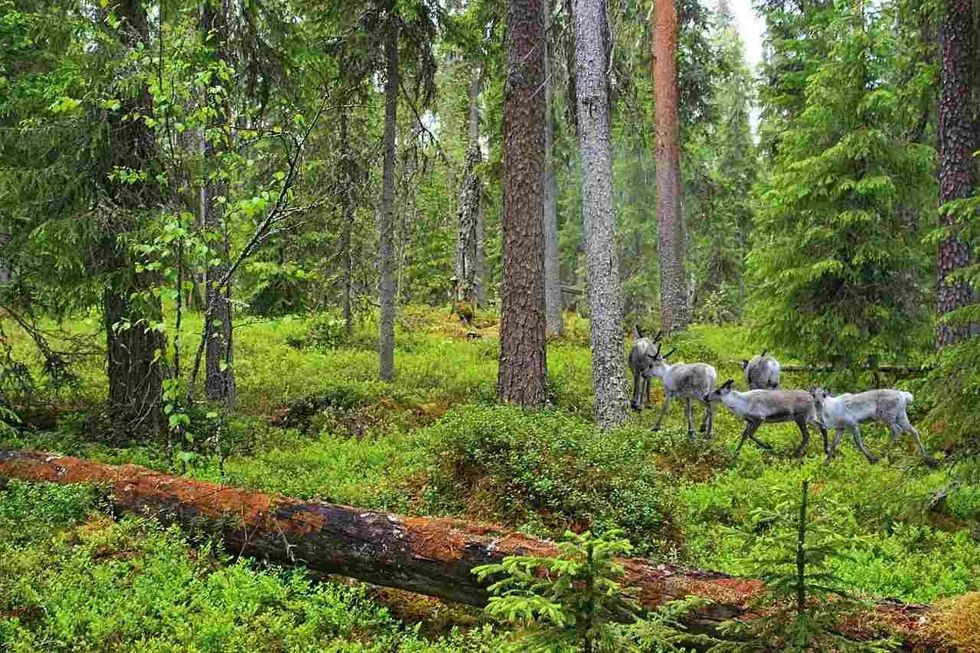Forests are a boon to human life if protected and maintained well.
Taiga forests are generally referred to as boreal forests, or snow forests, as they cover a large area, and are part of the world's largest land biome. Taiga is the name given to the barren areas approaching tree lines.
They are also referred to as boreal forests after the Greek god of the north wind, 'Boreas'. It is mostly covered with coniferous trees like pine, spruce, and fir trees.
These forests generally cover the Northern Hemisphere near the Arctic Circle. Taiga and tundra biomes are no different, except for the coniferous trees, as they aren't grown in the tundra. Taiga has the coldest weather in the forest biomes.
Weather And Climate Change
The Northern Hemisphere always has a cold climate because of its high latitude. Taiga forests are present in the far north, where the lowest temperatures are recorded. The land is mostly covered by snow, the elevation angle is high, and the day length differs from the tropical regions. Thus, the following factors affect the climate in the boreal zone:
- The lowest temperature recorded in the taiga biome is -76°F (-60°C), and winters last between five to seven months in this region.
- The highest temperature recorded in the taiga is 104°F (40°C), and summers last between one to four months.
- The sun is never overhead, which is at a 90° angle, due to its high latitude.
- The snow-covered regions amplify cooling as it reflects the solar radiation.
- The lowest temperatures were recorded in northeastern Russia compared to the temperatures recorded in North America.
- About 11,700 years ago, Pleistocene Ice Age glaciers retreated, thus forming the taiga region.
- The annual precipitation recorded was about 12-33 in (30-85 cm), and during summer, it either rains or snows and fog is formed.
- The evaporation is less than the annual precipitation in taiga biomes.
- Northern lights, or Aurora Borealis, can be viewed in taiga biomes as they occur due to the climatic conditions of this region.
Characteristics Of The Taiga Biome
The taiga covers up to 17% of the Earth's surface, which extends up to 6.5 million sq. mi (17 million sq. km). The climatic conditions of the land biomes consecutively define the characteristics of the taiga biome:
- The temperatures here are extremely low in winters and normal temperatures are recorded in summer.
- The taiga biome is extensively covered with numerous coniferous trees.
- The growing season for plants is short in this region.
- The soil layer is thin in this region compared to the tropics.
- The decaying process in the region is slow due to the cold temperatures.
Plants And Animals In The Taiga Biome
The taiga biome is home to numerous species of flora and fauna. Though the temperatures are cold, many animals and birds, normal and migratory, live here. Let us take a look at the exotic species of flora and fauna found in this biome:
- There are about 32,000 species of insects, 85 species of mammals, 130 species of fish, and several other birds and reptiles in the taiga region.
- Animals like squirrels and bears hibernate during winters, and squirrels store their food before their hibernation.
- Animals and reptiles migrate to the warmer areas in the taiga biome during winters.
- Natural vegetation isn't possible in the taiga due to the cold weather, thus, evergreen trees like coniferous trees are grown in this region.
- The plants here are adaptive to nature and have adaptable leaves, which is an inhibiting factor because of the absence of sunlight.
- The animal life here includes the Siberian tiger, Arctic fox, black bear, musk deer, and wood bison, to name a few.
- Mosses and dried leaves remain on the forest floor which matches the reddish-brown color of ermine fur.
- Mammoths likely lived in the taiga biome for five million years.
- Areas where patches of grass are grown are due to the reception of sunlight.
- The soil in the taiga is mostly wet and rocky.
- Coniferous trees have pointy edges for the snow to slide off the leaves after winters.
- Birds in this region are seed dispensers, while few are insect consumers.
External Environmental Threats
Forest biomes have many external environmental threats that affect animal and plant life. Many factors like climatic changes, human beings, and pollution affect the taiga. Let us examine some of these external threats faced by these forest biomes:
- Forest fires are frequent in this region due to lightning and human intervention.
- Insect outbreaks also weaken or kill trees in this region, making these trees less resistant to fire.
- Human-created disasters, like crude oil leakage, have happened in the river basins of Russia near the taiga region.
- Cutting down trees for wood logs is frequent in the taiga region, and due to this, plant species in the taiga are endangered and shrinking.
- In Russia, about 988,422 acres (400,000 hectares) of trees are cut down for logging every year.
- Global warming amplifies the decomposition in the taiga biome; as a result, it releases a high amount of carbon into the atmosphere, causing air pollution.
- Russia has most of its oil and gas sand mines, known as tar sands, in the taiga region, leading to deforestation.
- New insects and diseases attack the taiga and destroy these trees, like the white pine blister rust, a fungal disease that specifically targets pine trees.
- The incessant burning of fossil fuels contributes to acid rain in the taiga biome, which are more highly acidic than normal acid rain.
Plants and animals are a part of the forest, and the forest is a part of the Earth. These forests should be conserved and rather than disturbed or destroyed by artificial disasters.
Human life depends on these natural species as they are part of the food chain.
Living things are an important part of the food chain and, therefore, should be protected from extinction. The taiga biome is an important part of the Earth as it covers one-third of the forest area in the world and protects us from natural disasters.
FAQs
What are three facts about the taiga biome?
The lowest temperatures are recorded in the taiga compared to the Arctic. The taiga is covered with coniferous trees. It is the largest land biome globally.
What is special about a taiga?
Taiga has coniferous trees which can be adaptive to the lowest temperatures in winters.
Where is the taiga located?
The taiga is located in the Northern Hemisphere to the south of the Arctic Circle.
What is a boreal forest?
Boreal forests can be defined as forests that can withstand cold temperatures of the Northern Hemisphere all year-round.
What is another name for the taiga?
The taiga biome is also known as a boreal forest, or snow forest.
What is the largest biome in North America?
The taiga is the largest biome in North America as it covers Canada and Alaska and is contiguous to the United States.
Which biome has mainly coniferous trees?
The taiga in the Northern hemisphere has numerous coniferous trees.
Why is the taiga biome important?
The taiga covers over one-third of the world's forest area and is home to numerous plants and animals.
How do plants survive in the taiga?
Plants shed snow and retain moisture through needles on them, while the wax coating prevents evaporation and attracts sunlight.
How do animals survive in the taiga?
Animals in the taiga hibernate during winters, while few species of animals and birds migrate to other warmer regions during the winters.
Which biome has the shortest growing season?
The Arctic tundra biome has approximately 50-60 days, making it the shortest growing season.









